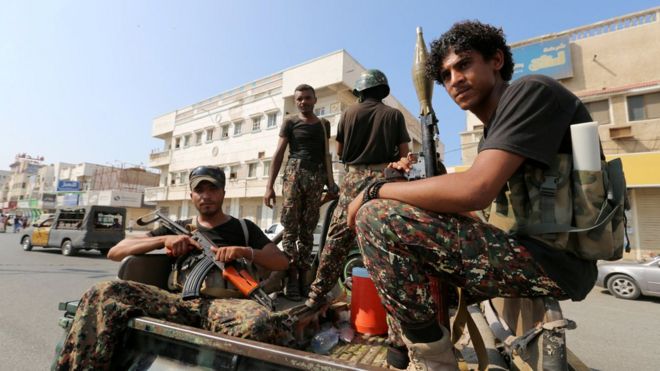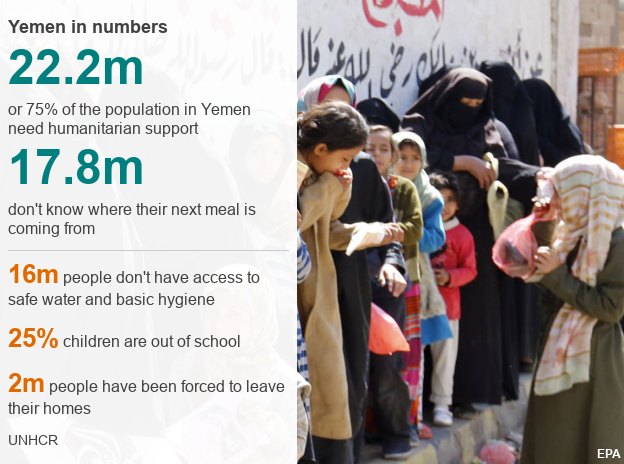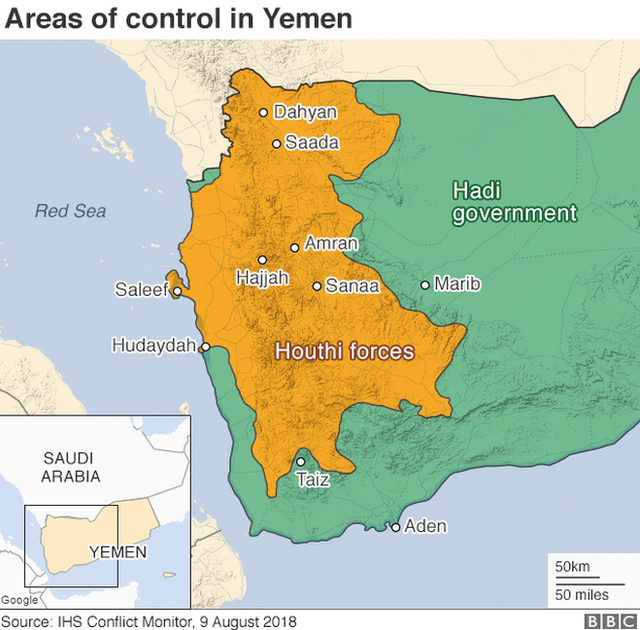
Fighting between Yemeni pro-government forces and Houthi rebels in the city of Hudaydah has reportedly subsided, after a ceasefire came into effect overnight.
Skirmishes continued for several hours following the start of the UN-brokered truce at midnight (21:00 GMT), but locals now say it is relatively calm.
UN envoy Martin Griffiths said the initiative seemed to be working so far.
The battle for Hudaydah threatened the operation of its port, which is crucial to the delivery of aid supplies.
Half of the war-torn country's population - 14 million people - are on the brink of famine and an estimated 85,000 children may have died from malnutrition.
Yemen has been devastated by a conflict that escalated in early 2015, when the Houthis seized control of much of the west of the country, including the capital Sanaa, and forced President Abdrabbuh Mansour Hadi to flee abroad.
Alarmed by the rise of a group they saw as an Iranian proxy, Saudi Arabia and eight other Arab states intervened in an attempt to restore the government.

'Yemenis hoping against hope'
By Lyse Doucet, chief international correspondent, BBC News
No-one expected the ceasefire to be smooth, simple, or straightforward. There is no trust between the warring sides. Both believe the other still wants a military solution.
The key to this truce largely holding will be the UN's presence on the ground and its ability to enforce the gradual pull-out of all forces and put in place a new order. That is why Martin Griffiths has called for its "swift" deployment.
Pressure from all the outside players in this war made this unexpected truce happen in a week of talks in Sweden. It is also essential if it is to hold. Saudi Crown Prince Mohammad Bin Salman, regarded as the architect of this war in Yemen, is said to be playing a key role in this shift from a military to a political push.
But the risk of an all-out assault on Hudaydah and Yemen's descent into famine still looms, if it all fails. Millions of Yemenis are hoping against hope that it holds.

What's happening on the ground?
The ceasefire covering the city of Hudaydah and the ports of Hudaydah, Salif and Ras Issa was first announced last week following talks in Sweden's capital, Stockholm. But it had to be delayed by several days because of fierce fighting.
The Houthis, who control the city and ports, and Yemen's government, whose forces are deployed to the south and east, have said they are now committed to abiding by the truce.
There were sporadic clashes along the front lines in Hudaydah city between 01:00 and 02:00 on Tuesday, with Yemeni officials accusing the Houthis of carrying out artillery strikes. However, residents said that by dawn the skirmishes had ended.
"The problem is that the forces have yet to disengage, and when they're close up to each other they are liable to respond to anything they see as a provocation or an alert," Mr Griffiths told the BBC.
"So we can expect some of this happening, but the pattern is a positive one."
A co-ordinator for Médecins Sans Frontières, Susana Borges, said hospitals it supported in Hudaydah were continuing to receive patients.
The UN has warned that in a worst-case scenario, the battle for Hudaydah could cost up to 250,000 lives and cut off aid supplies to millions elsewhere.
Its port is the principal lifeline for about two-thirds of Yemen's population, which is almost totally reliant on imports.
What happens next?
Under the Stockholm Agreement, once the ceasefire takes effect a "mutual redeployment of forces" shall be carried out from the city and ports "to agreed-upon locations outside".
Mr Griffiths said that the UN would convene, possibly on Wednesday, the first meeting of the Redeployment Co-ordination Committee, which will monitor implementation. It will include members of the warring parties and be chaired by the retired Dutch general, Patrick Cammaert.
The first phase of the redeployment will see troops withdraw from the ports and critical parts of the city associated with humanitarian facilities within two weeks and the UN taking a "leading role".
The full redeployment of all forces from the region should be completed within three weeks of the ceasefire entering into effect.


Mr Griffiths said this would include complete disengagement from the main road from Hudaydah to the capital Sanaa, which is crucial for the delivery of humanitarian supplies to the wider population.
The Stockholm Agreement should also see a prisoner swap and the facilitation of aid deliveries to the city of Taiz, which is besieged by the Houthis.
At least 6,660 civilians have been killed, according to the UN. The fighting and a partial blockade by the coalition have also left 22 million people in need of humanitarian aid, created the world's largest food security emergency, and led to a cholera outbreak that has affected 1 million people.

Source: https://www.bbc.com/news/world-middle-east-46600430



No comments:
Post a Comment